If you’re currently exploring new content management solutions in 2025, it’s highly probable that the term “headless CMS” has appeared repeatedly in your research.
There's a significant reason for this growing prominence: headless platforms have evolved from specialized developer tools into mainstream content powerhouses. They now fuel a diverse range of digital experiences, including websites, mobile applications, digital displays, and even cutting-edge voice and augmented reality (AR) interfaces.
So, what distinguishes these platforms? Unlike traditional content management systems like WordPress or Drupal, which embed your content within a specific website template, a headless CMS stores all content in a flexible, structured manner. It then delivers this content via robust APIs.
This architectural approach means your content gains unprecedented versatility, capable of residing and being displayed virtually anywhere: on your primary marketing website, within your mobile application, or even on the latest smartwatch worn by your customers.
The primary advantage of this model is the unparalleled freedom and inherent future-proofing it offers. You are no longer restricted to a single frontend presentation layer, allowing your development teams to innovate with the newest frameworks. Concurrently, your marketing teams benefit from modern, intuitive editing tools designed for efficiency.
In essence, a headless CMS provides a potent combination of speed, flexibility, and the crucial ability to effectively reuse and distribute content across all the diverse digital touchpoints your business requires.
This comprehensive guide will navigate through the leading headless CMS options available in 2025. We will detail who each platform is best suited for, highlight their most compelling features, and identify specific considerations to keep in mind during your evaluation.
What This Article Covers: A Quick Overview
- A concise introduction explaining the core concept of a "headless" CMS and the compelling reasons organizations are adopting this approach.
- An in-depth look at the top headless CMS platforms for 2025, spanning from industry-leading SaaS providers to innovative open-source trailblazers. We will emphasize their unique features and recent advancements.
- Expert guidance on how to effectively evaluate and compare various headless CMS platforms, using critical criteria such as editing user experience (UX), performance metrics, integrated AI capabilities, and composability.
- Strategic recommendations for teams embarking on the journey of selecting, implementing, or migrating to a headless CMS environment.
Quick Snapshot: The Headless CMS Landscape in 2025
It's important to recognize that not all headless CMS platforms are created equal. Below is an aerial view to help you quickly identify where your specific needs might align within the diverse market:
| Type | Best For | What You Get | Examples |
|---|---|---|---|
| Enterprise Headless CMS | Large teams requiring extensive governance, multi-language support, and personalization | Robust workflows, advanced security, AI integration, and seamless connections with CRM/CDP systems | Contentstack, Contentful, Kontent.ai |
| Headless CMS with Visual Editing Options | Marketing teams seeking real-time visual feedback as they construct content | Intuitive drag-and-drop interfaces, live previews, and flexible slice/block editors | Storyblok, Builder.io, Prismic |
| Developer-Led / Self-Hosted Headless CMS | Development-heavy organizations prioritizing full control and avoiding vendor lock-in | Complete code ownership, custom plugin development, and open-source adaptability | Strapi 5, Payload, Directus, Sanity |
| GraphQL-First Headless CMS | Teams demanding powerful APIs and advanced data federation capabilities | Flexible GraphQL queries and schema stitching across disparate data sources | Hygraph, DatoCMS |
| Budget-Friendly OSS | Small teams, personal side projects, and static site deployments | Free usage, Git-based workflows, and straightforward setup procedures | Decap CMS |
Our Approach: How We Selected These Platforms
While the market offers dozens of headless CMS options, not all possess the same level of maturity or widespread adoption. For this guide, our selection process focused on reviewing the most established and rapidly expanding platforms.
Our methodology involved analyzing a combination of key factors: recent product innovations, overall industry momentum, and, crucially, authentic user feedback gathered from reputable review sites such as G2, Capterra, and TrustRadius.
We meticulously assessed how customers rated these tools across several dimensions, including ease of use, the quality of the editor experience, developer flexibility, and the responsiveness of support.
The outcome is a carefully curated shortlist that comprehensively covers the primary categories within the headless CMS landscape: prominent enterprise SaaS leaders, platforms excelling in visual editing, robust developer-led and open-source solutions, and specialized GraphQL-first systems.
Every headless CMS featured here is not only actively developed and evolving in 2025, but also boasts a proven track record of empowering teams to successfully deliver real-world projects at scale, demonstrating reliability and future potential.
Enterprise-Level Headless CMS Options
1. Contentful – Enterprise Composable Content
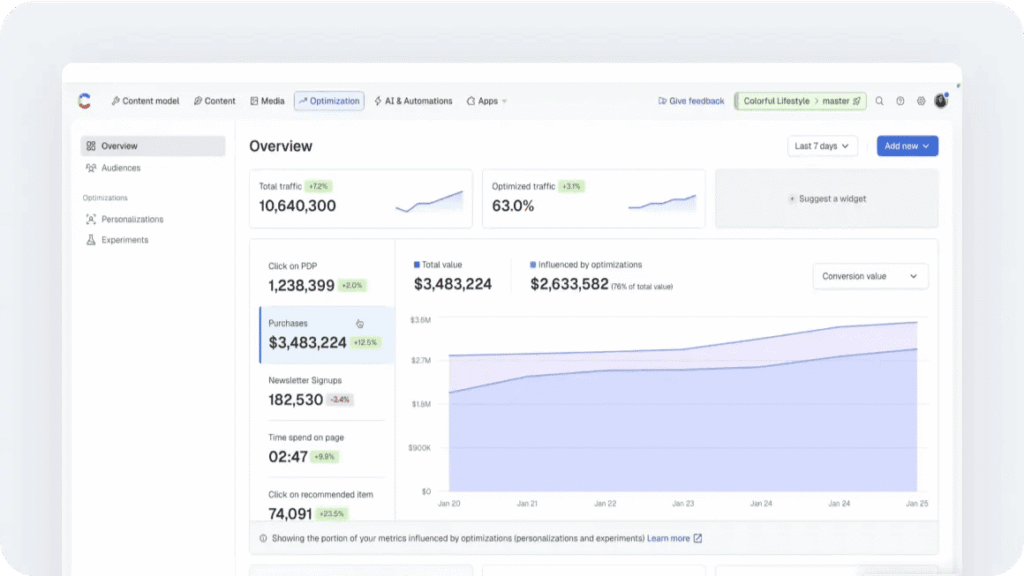
Contentful stands as one of the most widely adopted headless CMS platforms, firmly established within the enterprise SaaS category. It presents itself as a “composable content platform,” designed to enable organizations to seamlessly unify content across a multitude of digital experiences, all while upholding paramount standards of scalability, robust governance, and operational speed.
Best For
- Large enterprises and mid-to-large organizations operating with distributed teams across various locations.
- Businesses with a strong need for stringent governance, sophisticated role-based workflows, and comprehensive localization capabilities.
- Companies aiming to integrate a CMS effectively into a broader, modular composable DXP (Digital Experience Platform) stack.
Standout Features
- Contentful Studio (Launched 2025): A powerful low-code, visual workspace specifically designed to empower marketers and product owners to construct digital experiences without encountering developer bottlenecks, accelerating time to market.
- AI-Driven Content Modeling & Authoring: Leverages artificial intelligence to assist in the intelligent structuring, efficient generation, and large-scale localization of content, significantly reducing manual effort.
- Extensive Ecosystem: Boasts a robust marketplace brimming with prebuilt applications and seamless integrations covering critical areas like e-commerce, analytics, Digital Asset Management (DAM), and Customer Data Platforms (CDP).
- Scalability: Engineered from the ground up to effortlessly manage enterprise-level content operations, supporting multiple channels, diverse brands, and various global regions.
Recent Developments
- The year 2025 witnessed a strategic expansion into advanced personalization and orchestration functionalities, broadening Contentful’s role from a core CMS to an integral component of the wider composable DXP ecosystem.
- Continuous and substantial investment in AI features aimed at accelerating content creation and significantly reducing the manual workload for content editors.
Considerations
- Pricing can escalate considerably as additional environments, locales, and user accounts are introduced, warranting careful budget planning.
- While inherently developer-friendly, smaller teams might perceive its enterprise-centric orientation as more extensive or complex than their specific requirements demand.
2. Contentstack – CMS Evolving into an Adaptive DXP
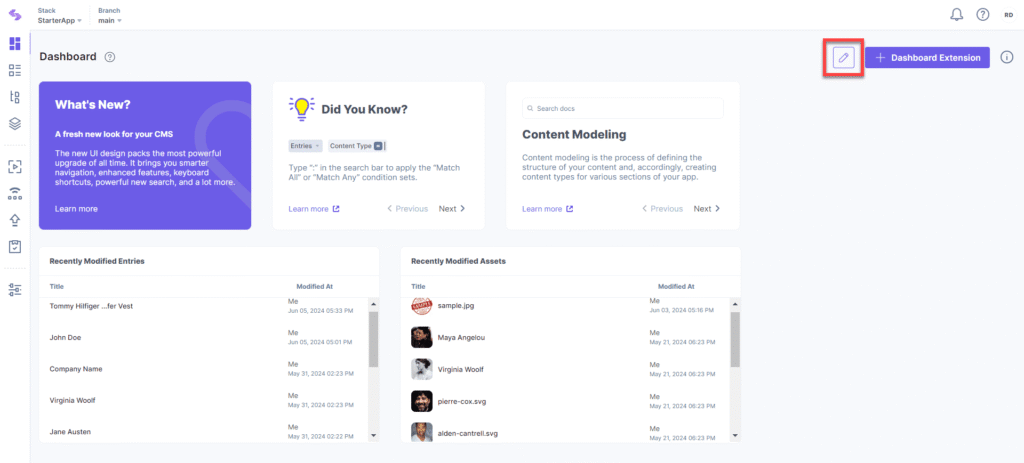
Contentstack has firmly cemented its position as a frontrunner in the enterprise SaaS headless CMS arena. Its core focus is on empowering organizations to transcend basic content management and delve into the comprehensive composition of full digital experiences (DXP). It distinguishes itself through advanced workflow capabilities, robust enterprise governance, and an expanding suite of integrated AI and personalization tools, making it a compelling choice for sophisticated digital strategies.
Best For
- Enterprises that prioritize delivering highly personalized, omnichannel experiences to their customers.
- Organizations with a critical need for rigorous governance structures and efficient workflow management processes.
- Teams dedicated to constructing a composable DXP that leverages real-time data and advanced orchestration capabilities.
Standout Features
- EDGE DXP (2025 Launch): A groundbreaking unified platform that intelligently combines CMS functionalities with personalization, orchestration, and analytics, enabling the delivery of dynamic, real-time digital experiences.
- Lytics CDP Integration (via 2025 Acquisition): Through a strategic acquisition, deep audience segmentation and sophisticated personalization capabilities are now natively available directly within the Contentstack platform, enhancing targeted content delivery.
- Enterprise-Grade Workflows: Features include role-based governance, multi-stage approval chains, and advanced localization tools, all meticulously designed to meet the complex demands of global organizations.
- Composable Architecture: Offers robust integrations with leading commerce platforms, analytics solutions, Digital Asset Management (DAM) systems, and marketing automation platforms, fostering a truly composable digital ecosystem.
Recent Developments
- January 2025: Acquired Lytics, a prominent customer data platform, significantly augmenting Contentstack’s personalization and data management capabilities.
- February 2025: Introduced EDGE DXP, a pivotal moment signaling its strategic evolution from a pure CMS provider to a comprehensive, broader composable experience platform.
- Ongoing, substantial investment in AI-assisted authoring and intelligent content orchestration, streamlining content creation and distribution processes.
Considerations
- Positioned at the premium end of the market, its cost structure and the effort required for implementation directly reflect its enterprise-level focus and extensive feature set.
- For smaller or less digitally mature teams, the platform may present a level of complexity that exceeds their immediate needs, potentially leading to underutilized features.
3. Kontent.ai – Enterprise Modular Content at Scale
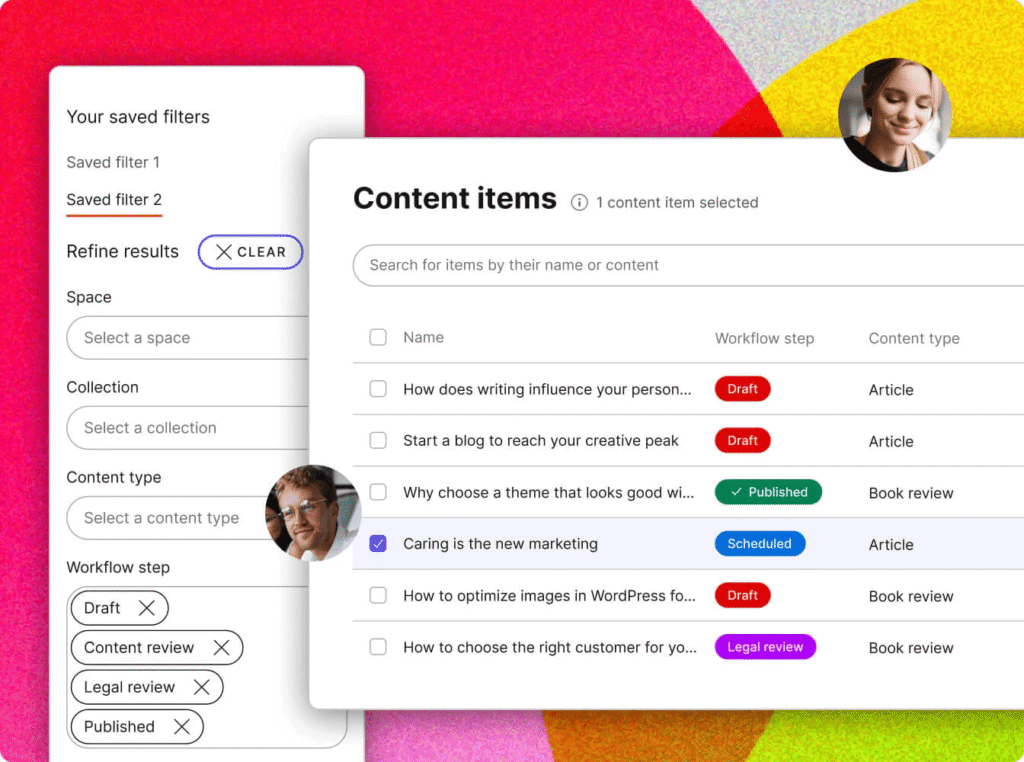
Kontent.ai is a highly specialized modular content platform, meticulously engineered for enterprises that manage intricate content operations on a vast scale. Emerging as a spin-off from Kentico, it has successfully established a distinct niche as a governance-focused, API-first CMS. It masterfully balances the stringent enterprise requirements for compliance and structured content with the modern demand for flexible content delivery, making it a powerful choice for regulated industries.
Best For
- Large organizations tasked with managing multi-brand and multi-language content ecosystems.
- Teams that require strict governance protocols, robust compliance adherence, and comprehensive auditability for all content actions.
- Enterprises seeking a highly reliable, API-first CMS that is complemented by powerful and intuitive editorial tooling.
Standout Features
- Structured Content Modeling: Provides flexible schema design capabilities to meet diverse enterprise content requirements, coupled with advanced localization and sophisticated taxonomy management features.
- Workflow & Governance: Offers granular permissions, multi-stage role-based approvals, and compliance-ready audit trails, ensuring complete control and accountability.
- API-First Delivery: Engineered with high-performance REST and GraphQL APIs, specifically designed to ensure optimal content delivery across global deployments and diverse channels.
- Collaboration Tools: Features an editor-friendly interface enriched with inline comments, real-time collaboration capabilities, and robust preview functionalities, fostering seamless teamwork.
- Enterprise Integrations: Includes out-of-the-box connectors for essential enterprise systems such as commerce platforms, analytics suites, and Digital Asset Management (DAM) solutions.
Recent Developments
- Successfully rebranded as Kontent.ai, strategically reinforcing its identity as an independent, forward-thinking, and AI-powered headless platform.
- Expanded its suite of AI features to actively assist with content generation, intelligent tagging, and streamlined localization processes.
- Continued significant investment in enhancing the editor experience, making the platform more accessible and intuitive for non-technical users, all while rigorously preserving enterprise-level control and security.
Considerations
- Positioned squarely at enterprise-level buyers, the platform might feel overly comprehensive or "overbuilt" for mid-market organizations with simpler content needs.
- While integrations with common enterprise systems are robust, it currently possesses less marketplace depth compared to ecosystems offered by Contentful, though this is continually evolving.
Best CMS with Visual Editing Capabilities
1. Storyblok – Headless with a True Visual Editor
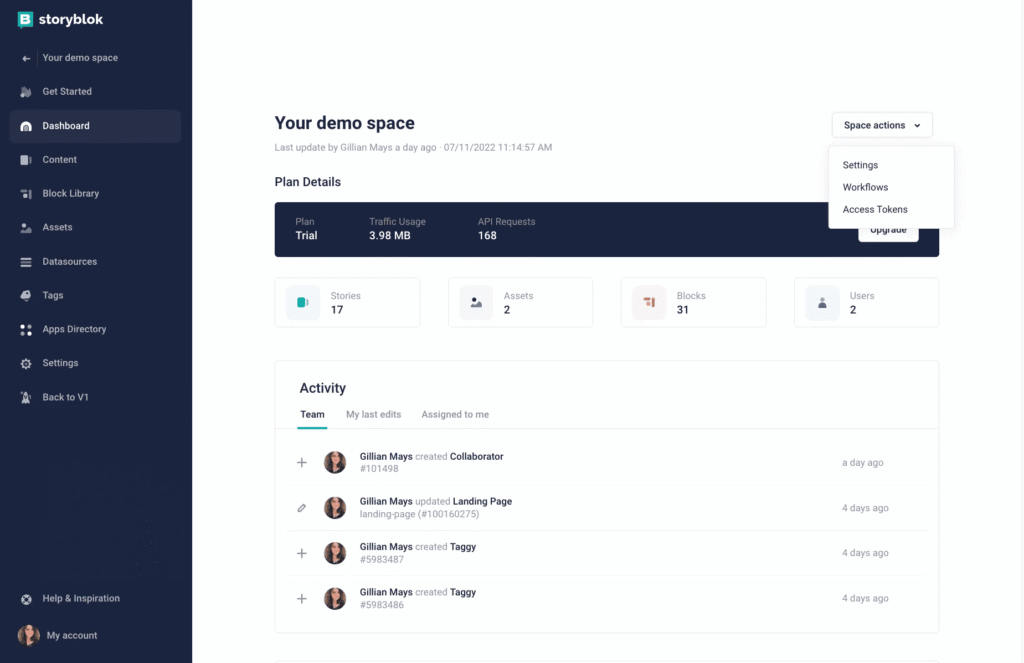
Storyblok is a leading visual editing headless CMS, meticulously crafted to provide marketers and content teams with the intuitive ease of a page builder, without ever compromising the inherent flexibility of an API-first backend. Its defining characteristic is the groundbreaking Visual Editor, which delivers a live, on-page editing experience. This makes Storyblok one of the most accessible and user-friendly headless platforms for individuals without a technical background.
Best For
- Marketing teams who desire an intuitive, what-you-see-is-what-you-get (WYSIWYG) editing experience for rapid content creation.
- Businesses that seek to strike an optimal balance between developer flexibility and exceptional editor usability.
- Organizations in search of a scalable SaaS CMS that provides robust support for comprehensive localization efforts across multiple regions.
Standout Features
- Visual Editor: Offers real-time, on-page editing complete with dynamic drag-and-drop functionality for content blocks, intelligently referred to as “components.”
- Component-Based Architecture: Developers construct reusable content blocks, while editors effortlessly compose full pages visually using these predefined blocks, ensuring consistency and speed.
- Multilingual Capabilities: Boasts advanced localization tools that are essential for efficient global content operations, supporting diverse languages and regional nuances.
- Collaboration & Workflows: Integrates comprehensive roles, permissions, and approval processes, specifically designed to facilitate seamless team environments and efficient content governance.
- Marketplace & Integrations: Provides a rich ecosystem of plugins for vital functions such as e-commerce, analytics, Digital Asset Management (DAM), and a variety of other essential tools.
Recent Developments
- Between 2024 and 2025, Storyblok significantly expanded its Visual Editor capabilities, introducing even richer preview functionalities and advanced collaborative features to enhance teamwork.
- There's a growing strategic emphasis on enterprise-readiness, with continuous enhancements in performance, governance frameworks, and deeper integration possibilities.
- Ongoing investment in strengthening its partner ecosystem, solidifying Storyblok as a compelling choice for agencies and implementation partners delivering complex projects.
Considerations
- While the editor experience is consistently rated as excellent, developers might find it offers less granular customization compared to schema-as-code systems like Sanity, which provide deeper programmatic control.
- SaaS pricing can escalate with increased usage, particularly for organizations managing a multitude of sites or numerous locales, requiring careful budget forecasting.
2. Builder.io – Visual Development + Headless Content
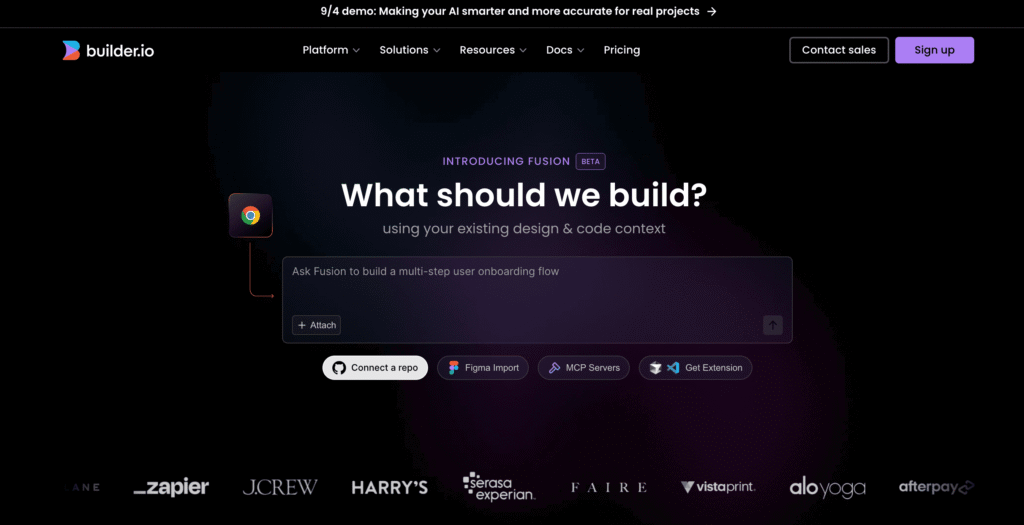
Builder.io positions itself as an innovative visual development and content platform, expertly engineered to bridge the crucial gap between marketing teams and developers. It delivers powerful drag-and-drop editing capabilities built atop a robust headless architecture, showcasing particular strength in e-commerce environments and advanced experimentation scenarios.
Distinct from many traditional headless CMS solutions, Builder.io places a significant emphasis not only on efficient content delivery but also on integrated A/B testing, personalized experiences, and comprehensive performance optimization, making it a holistic digital experience solution.
Best For
- Marketing and e-commerce teams that demand the ability to rapidly iterate and launch campaigns without constant reliance on developer resources.
- Organizations actively seeking a CMS that inherently supports advanced experimentation and personalization functionalities directly out of the box.
- Teams that value sophisticated visual editing and integrated analytics alongside a flexible, API-driven content delivery system.
Standout Features
- Visual Editor: A genuine no-code environment where marketers can intuitively drag-and-drop content sections, update entire pages, and launch complex campaigns with minimal to no developer intervention, dramatically speeding up content cycles.
- Experimentation & Personalization: Features robust, built-in A/B testing, advanced audience targeting, and seamless analytics integrations. These tools are designed to optimize digital experiences by continuously learning and adapting.
- Composable Content Hub: Its API-first architecture guarantees that content can be effortlessly delivered to any digital endpoint, extending far beyond conventional web storefronts.
- Integrations with Frontend Frameworks: Offers strong native support for popular frameworks such as Next.js and React, alongside deep integrations with leading e-commerce platforms like Shopify and BigCommerce.
- Performance Optimization: Includes critical features like intelligent image optimization, edge delivery for speed, and specialized SDKs tailored for modern web frameworks, ensuring fast loading times and smooth user experiences.
Recent Developments
- Between 2024 and 2025, Builder.io significantly expanded its visual experimentation tools, further solidifying its appeal for dynamic e-commerce and high-growth marketing teams.
- Enhanced integrations with leading commerce and analytics platforms, positioning Builder.io as a strong contender within the rapidly evolving composable commerce ecosystem.
- A continued strategic focus on refining the developer experience, ensuring that engineering teams can easily extend the platform with custom components and bespoke APIs, maintaining ultimate flexibility.
Considerations
- This platform is most effectively utilized by teams that will actively leverage its experimentation and personalization layers; otherwise, some of its advanced features might feel like unnecessary overhead.
- Its SaaS model, with premium capabilities tied to usage and experimentation volume, can lead to escalating costs at scale, necessitating careful financial planning.
3. Prismic – Slice-Based Page Building
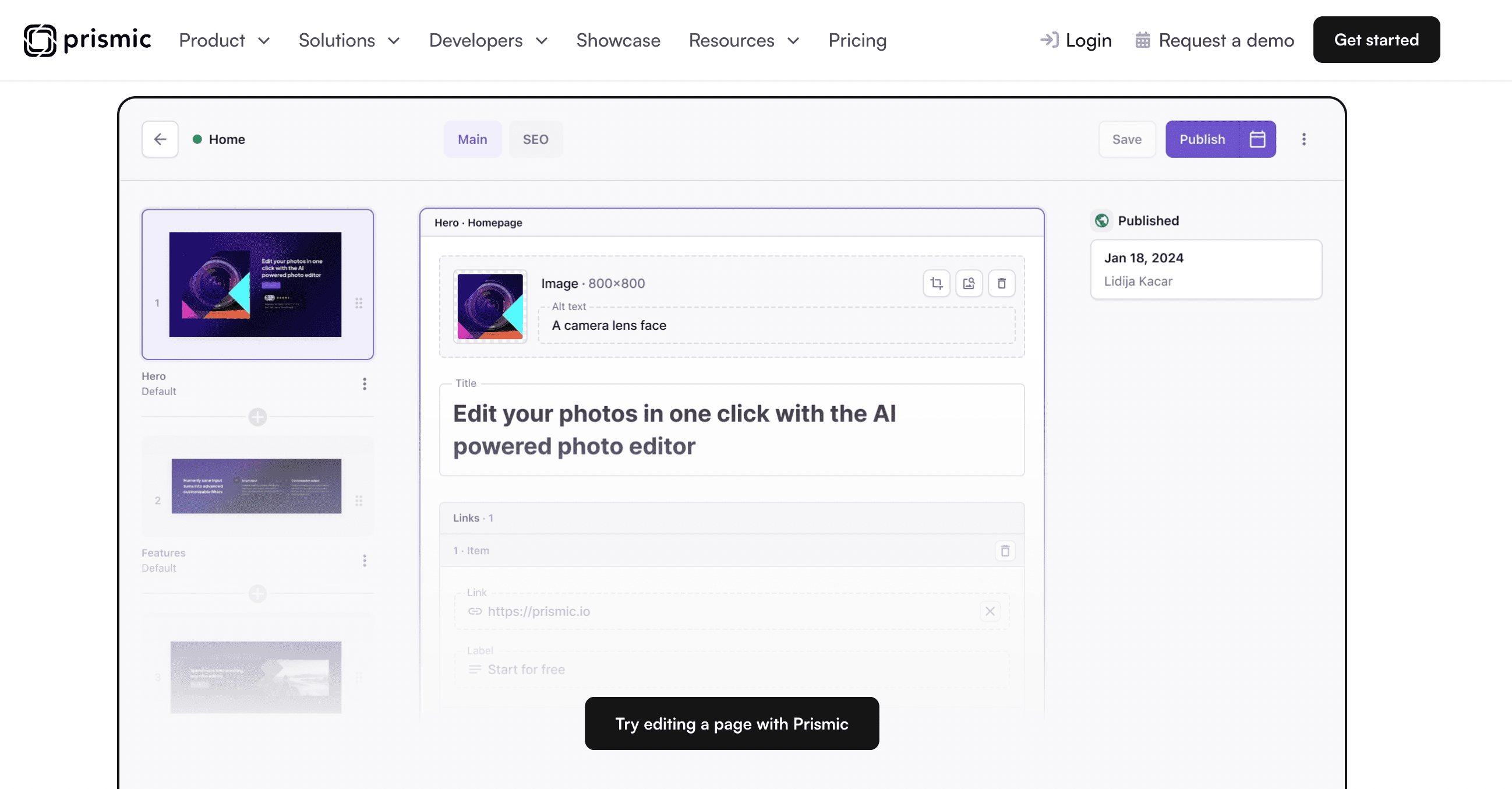
Prismic is a sophisticated headless CMS that places a strong emphasis on simplicity and empowering editorial freedom, widely recognized for its innovative “Slice” approach. Rather than imposing rigid templates, developers construct reusable “Slices” – essentially independent content blocks – which marketers can then intuitively assemble into fully formed pages. This distinctive methodology makes Prismic particularly attractive to teams striving for a harmonious balance between consistent design guidelines and expansive editorial flexibility.
Best For
- Content and marketing teams who prioritize quickly composing pages with minimal reliance on developer intervention, fostering greater autonomy.
- Design-conscious organizations that are committed to maintaining consistent branding and visual identity across all their digital properties.
- Companies seeking a straightforward, editor-friendly SaaS CMS complemented by transparent and predictable pricing models.
Standout Features
- Slice Machine: A powerful tool where developers define all content components (the “Slices”), which editors then utilize to visually construct pages with intuitive drag-and-drop flexibility, ensuring design integrity.
- Visual Page Builder: Empowers marketers to preview their content updates and publish changes with minimal technical support, significantly accelerating content publication cycles.
- Multi-Channel Delivery: All content adheres to an API-first principle, ensuring its versatility and usability across a wide array of digital platforms, not just traditional websites.
- Integration Ecosystem: Offers a rich collection of plugins and Software Development Kits (SDKs) tailored for popular frontend frameworks such as Next.js, Nuxt, and React, facilitating seamless integration.
- Developer Workflow Support: Provides robust support for Git-based versioning and command-line tools, streamlining the developer setup and deployment processes.
Recent Developments
- Continued significant investment in the Slice Machine, enhancing its capabilities and fostering even tighter integration with contemporary design and development workflows.
- Between 2024 and 2025, Prismic introduced improved preview environments and refined the editor UX, making it considerably easier for marketers to visualize changes before they go live.
- Expanded integration options for a broad spectrum of popular frontend frameworks and leading e-commerce solutions, broadening its applicability across diverse tech stacks.
Considerations
- Compared to enterprise-grade platforms like Storyblok or Contentful, Prismic offers a lighter set of enterprise governance features, which might be a factor for highly regulated environments.
- It is optimally suited for small-to-mid-sized teams; larger enterprises might find its feature depth somewhat limiting for complex global use cases or highly bespoke requirements.
GraphQL-First Headless CMS Platforms
1. Hygraph – GraphQL-Native with Content Federation
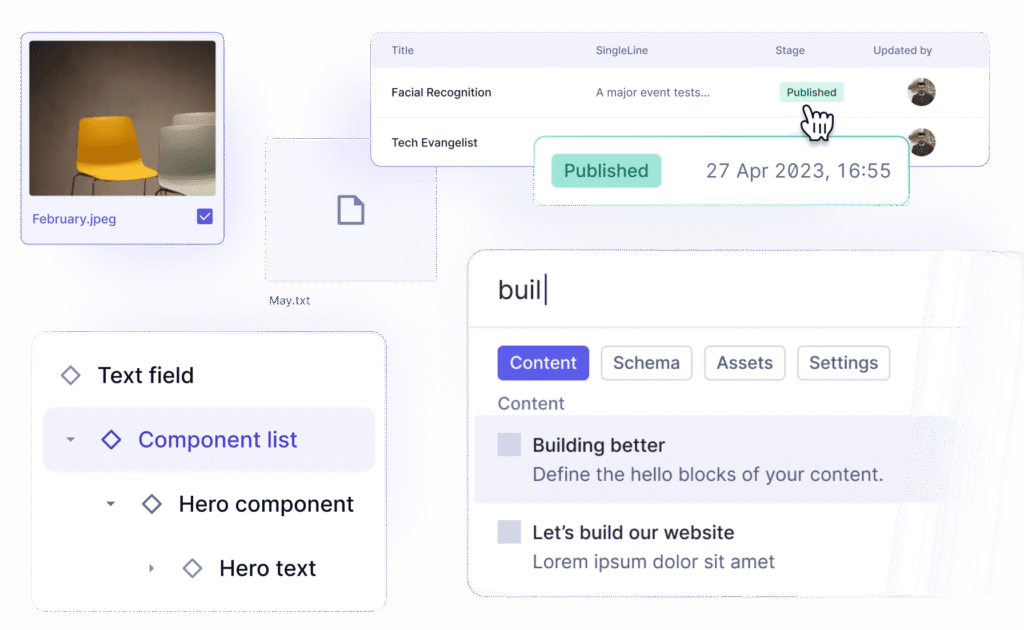
Hygraph is a cutting-edge GraphQL-native headless CMS, specifically engineered for teams that need to unify and efficiently distribute content across a multitude of diverse digital products. Its most compelling and distinctive feature is Content Federation, which allows organizations to seamlessly pull data from a wide range of external sources—including commerce platforms, Product Information Management (PIM) systems, and Digital Asset Management (DAM) solutions—and serve it all through a single, cohesive GraphQL API.
This powerful capability makes Hygraph an exceptional choice for companies managing intricate, multi-source content ecosystems, simplifying data access and content orchestration.
Best For
- Organizations that aspire to consolidate all their content and related data under a single, unified GraphQL API, streamlining data access.
- Teams operating with multiple backend systems (e.g., e-commerce, DAM, CRM) that require a robust solution to bring them together into a cohesive whole.
- Developer-heavy organizations that highly prioritize GraphQL's inherent performance benefits and its unparalleled flexibility for complex data queries.
Standout Features
- Content Federation: Facilitates seamless connections with external APIs and services, intelligently merging their data into a unified GraphQL schema, simplifying complex data landscapes.
- GraphQL API-first: Every piece of content, without exception, is meticulously accessible via GraphQL, offering powerful filtering, relationship management, and real-time query capabilities.
- Editor-Friendly UI: Provides a clear and intuitive user interface for structured content creation, complete with integrated workflows and comprehensive localization support, empowering content teams.
- Enterprise Features: Includes critical functionalities such as granular role-based access control, Single Sign-On (SSO) integration, and detailed audit logs to ensure robust governance and security.
- Marketplace: Offers a growing selection of integrations for essential functions like e-commerce, search, Digital Asset Management (DAM), and advanced analytics platforms.
Recent Developments
- Hygraph significantly expanded its Content Federation capabilities, strategically positioning itself as far more than just a CMS—evolving into a comprehensive content integration hub.
- Continued substantial investments in optimizing performance and advanced caching mechanisms specifically for high-scale GraphQL content delivery, ensuring rapid response times.
- Key UI improvements between 2024 and 2025 have made the editor experience even more intuitive and user-friendly, all while meticulously preserving the platform's core developer flexibility.
Considerations
- Its strong GraphQL focus might be an excessive solution for smaller teams that do not require such complex integrations or highly sophisticated data querying.
- The federation features genuinely excel in multi-system architectures; simpler content use cases might find other platforms to be more cost-effective without compromising core needs.
2. DatoCMS – GraphQL, Media Pipeline, Strong Authoring
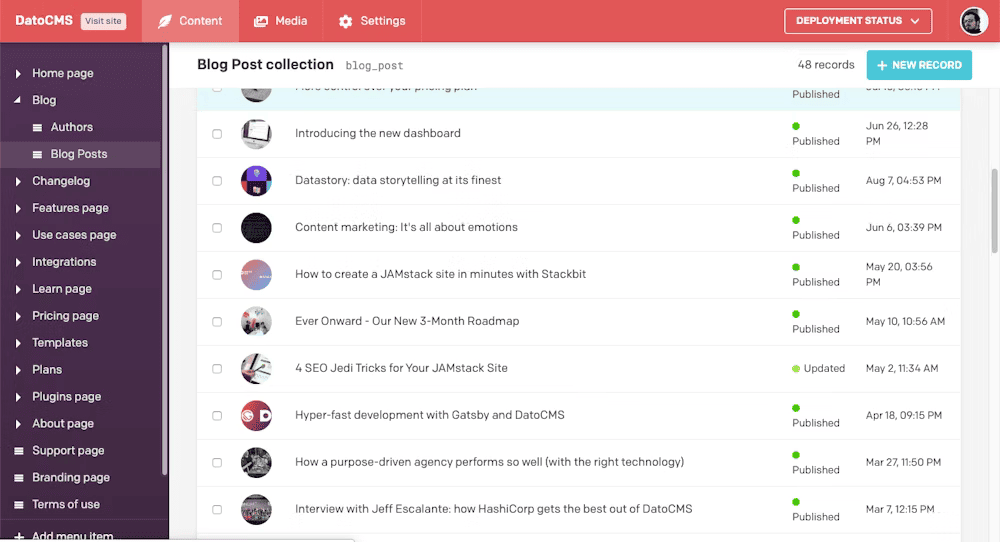
DatoCMS is a modern SaaS headless CMS that places a significant emphasis on GraphQL delivery, exceptional performance, and comprehensive localization capabilities. Renowned for its developer-friendly APIs and a highly polished, intuitive editor experience, it has become a preferred choice among teams that demand fast, globally distributed content delivery, seamlessly paired with a clean and efficient authoring interface. Its integrated CDN and robust media pipeline make it particularly appealing for organizations that prioritize blazing-fast performance and optimal asset delivery.
Best For
- Teams that require a rapid, highly reliable GraphQL API without the burden of extensive developer setup and configuration.
- Organizations managing large volumes of multi-language content that needs to be scaled and distributed globally.
- Businesses that value a harmonious balance between powerful developer tooling and a highly intuitive, user-friendly editor interface.
Standout Features
- First-Class GraphQL: Offers highly flexible queries complete with advanced filtering, relationship management, and real-time content updates, ensuring dynamic data access.
- Global CDN Delivery: Includes a built-in edge caching mechanism for both content and digital assets, guaranteeing lightning-fast delivery worldwide.
- Media Pipeline: Provides sophisticated image and video optimization, on-the-fly transformations, and responsive delivery, ensuring assets are perfectly adapted for any device.
- Editor-Friendly UI: Features a clean, uncluttered interface, inline editing capabilities, and intelligent workflows that expertly balance content structure with remarkable ease of use for content creators.
- Localization Tools: Boasts advanced support for comprehensive multi-language content management, enabling seamless global content strategies.
Recent Developments
- Expanded media handling capabilities, including advanced video delivery pipelines and cutting-edge edge optimizations, further enhancing rich media management.
- Continuous and iterative improvements to the editor UI, resulting in an even smoother and more intuitive experience for non-technical users, reducing the learning curve.
- Significant enhancements to GraphQL performance and increased API limits, making DatoCMS robust enough for demanding, enterprise-scale projects.
Considerations
- The SaaS pricing model scales with usage (e.g., records, API calls, locales), which can accumulate for very large enterprises, requiring careful cost management.
- It is generally less extensible than open-source alternatives like Strapi or Payload, as significant customization depends primarily on the vendor's product roadmap.
- Possesses a smaller ecosystem compared to the more established Contentful or Contentstack, although its integrations cover most common and essential business needs effectively.
Developer-Led / Self-Hosted Headless CMS Platforms
1. Strapi 5 – Open-Source, Self-Hosted Control
Strapi is unequivocally the most popular open-source headless CMS, providing development teams with an unparalleled degree of control over hosting, comprehensive customization, and deep extensibility. With the highly anticipated release of Strapi v5 in September 2024, the platform has doubled down on TypeScript integration, refined its plugin architecture, and significantly bolstered its enterprise-readiness. This makes Strapi an exceptionally strong choice for organizations that place a premium on ownership and ultimate flexibility over the inherent convenience of SaaS solutions.
Best For
- Development teams that demand full control over their content management system, whether opting for self-hosted deployment or managed cloud solutions.
- Organizations with robust engineering resources that exhibit a clear preference for open-source software, valuing transparency and community-driven development.
- Businesses that require highly custom APIs, bespoke plugins, or complex, integration-heavy workflows tailored to unique operational needs.
Standout Features
- Open-Source & Self-Hosted: Offers complete freedom to deploy and run the platform on your own infrastructure, or leverage Strapi Cloud for convenient managed hosting.
- API-First Architecture: Automatically generates both REST and GraphQL APIs directly from your defined content models, accelerating development.
- Plugin Ecosystem & SDK: Developers possess the ability to build custom plugins or install existing ones to extend core functionality, covering areas like authentication, advanced workflows, and Digital Asset Management (DAM).
- TypeScript-Native: The introduction of strong typing support in v5 significantly enhances developer productivity, improves code stability, and reduces common errors.
- Content Preview & Versioning: New features in v5 significantly elevate editorial workflows, bringing them closer to parity with capabilities offered by leading SaaS competitors, enhancing content governance.
Recent Developments
- Strapi v5 Release (2024): A monumental update that brought native TypeScript support, a completely re-engineered plugin system, and enhanced developer tooling, marking a significant leap forward.
- Expanded Strapi Cloud offerings, providing flexible managed hosting options for teams that desire convenience without sacrificing the inherent flexibility of an open-source solution.
- Growing adoption within enterprise and agency environments as the platform's governance and workflow features continue to mature and meet increasingly complex demands.
Considerations
- Compared to turnkey SaaS solutions, Strapi requires a certain level of technical expertise for initial setup, ongoing scaling, and routine maintenance.
- Advanced enterprise features, such as Single Sign-On (SSO) and role-based workflows, are available but often necessitate additional configuration or specific enterprise licensing.
- While continuously improving, the editor experience remains more developer-centric compared to visually-oriented platforms like Storyblok or Builder.io, which prioritize ease of use for non-technical users.
2. Payload – Next.js-Native, Code-First Control
Payload is an innovative, developer-first, self-hosted headless CMS meticulously built using Node.js and TypeScript. It is characterized by its deep focus on extensibility and optimized performance, making it a powerful choice for modern web development. Payload seamlessly integrates with contemporary frameworks, with a particularly strong synergy with Next.js, and grants teams complete ownership over their codebase and underlying infrastructure.
Its robust access control mechanisms, comprehensive file management capabilities, and a distinctly code-first approach make it especially appealing to engineering-driven organizations that demand maximum control and flexibility.
Best For
- Engineering teams that demand full-stack control over both their CMS and hosting environment, from the ground up.
- Projects that are primarily built with modern JavaScript frameworks such as Next.js, React, or that heavily utilize TypeScript for development.
- Organizations that prioritize granular access control permissions and the ability to implement highly custom backend logic to meet unique business requirements.
Standout Features
- Code-First Content Modeling: Content types and schemas are defined directly within code, allowing for robust versioning, seamless integration with developer workflows, and greater consistency.
- Advanced Access Control: Enables the creation of highly fine-grained authorization rules, written directly in JavaScript/TypeScript, to support complex and intricate permission structures.
- Next.js Native Support: Architected to pair perfectly with modern frameworks, offering specialized starter kits and deep integration capabilities, particularly for Next.js projects.
- Media & File Handling: Provides robust capabilities for file uploads, intelligent image resizing, and flexible integrations with various storage solutions, simplifying asset management.
- GraphQL and REST APIs: Automatically generated from your content models, offering versatile API endpoints to cater to diverse content delivery needs across different applications.
Recent Developments
- Payload v3 (2025): A significant major release that heavily focused on enhancing performance, improving scalability, and expanding its cloud support options for greater deployment flexibility.
- Introduced substantial improvements to the admin UI, delivering an even more polished and intuitive editorial experience for content managers.
- Enhanced cloud deployment options, making Payload more accessible and convenient for teams who prefer not to manage their own hosting infrastructure.
Considerations
- This platform is optimally suited for developer-led teams; marketing professionals might find the editorial tools less intuitive compared to visual-first SaaS offerings.
- Requires a certain level of hosting and DevOps setup expertise, unless leveraging Payload Cloud for managed services.
- While experiencing rapid growth, its ecosystem and marketplace are currently smaller compared to established open-source incumbents like Strapi, though this is actively evolving.
3. Directus – Database-First Headless / Data Platform
Directus is a unique database-first headless CMS and a versatile data platform that intelligently layers an API and a no-code administrative application on top of virtually any SQL database. Distinct from most headless CMS platforms that maintain their own internal content structures, Directus establishes a direct connection to your existing database schema. From this connection, it instantly generates fully functional REST and GraphQL APIs, alongside a sleek and intuitive admin UI, streamlining data management significantly.
This innovative approach makes Directus particularly appealing for data-intensive applications where the CMS needs to coexist and integrate seamlessly with pre-existing systems and data sources.
Best For
- Engineering teams that possess existing SQL databases and desire a CMS solution without the need for extensive data migration.
- Organizations engaged in building custom applications or intricate dashboards that require a unified system for both content and data management.
- Teams that highly value flexibility in data modeling, extending beyond the conventional structures typically offered by traditional CMS platforms.
Standout Features
- Database-First Approach: Establishes direct connections to popular SQL databases such as MySQL, Postgres, SQLite, and others, eliminating the necessity to alter your existing database schema.
- Automatic APIs: Instantly generates comprehensive REST and GraphQL APIs directly from your database, providing immediate access to your data.
- No-Code Admin App: Delivers an elegant and intuitive user interface that empowers non-technical users to efficiently manage both data and content without developer assistance.
- Extensibility: Built with a modular architecture that supports custom hooks, extensions, and tailored endpoints, allowing for profound customization and integration.
- Open Source & Self-Hosted: Offers the flexibility to run the platform anywhere you choose, or opt for Directus Cloud for a convenient managed hosting solution.
Recent Developments
- Continuous and significant investment in Directus 10, bringing forth substantial improvements to the user experience (UX), enhanced role-based access controls, and superior performance.
- Expanded its robust extension framework, making it considerably easier for developers to customize the platform and integrate additional features tailored to specific needs.
- Gaining increasing traction as both a versatile CMS and a general-purpose data management layer, particularly for bespoke application development.
Considerations
- It is most effectively suited for projects that already heavily depend on relational data models, aligning perfectly with existing database structures.
- Optimal for developer-led teams; marketing users might find the editing experience less refined or intuitive compared to visually-oriented platforms like Storyblok or Builder.io.
- Requires a degree of hosting and database management expertise unless opting for the managed services provided by Directus Cloud.
4. Sanity – Schema-as-Code with AI Assist
Sanity is a highly regarded schema-as-code headless CMS that enjoys a strong reputation among developers for its exceptional flexibility and profound extensibility. At its technological core lies the Sanity Studio, a highly customizable, React-based editing environment that can be meticulously tailored to align with virtually any unique workflow or content requirement. Furthermore, Sanity offers the innovative Content Lake, a real-time, instantly queryable datastore that ensures content is immediately available and consistently updated across all channels and applications.
With the recent addition of AI Assist, Sanity has strategically expanded its usability for non-technical teams, all while steadfastly upholding its fundamental developer-first ethos, creating a powerful blend of control and accessibility.
Best For
- Developer-heavy teams that prioritize the flexibility and version control offered by a schema-as-code approach for their content models.
- Organizations actively seeking a CMS that can be extensively customized and deeply integrated to perfectly fit highly specific and unique workflows.
- Teams that desire a robust balance between powerful, flexible APIs and a suite of editor-focused features designed to enhance content creation and management.
Standout Features
- Sanity Studio: An open-source, React-based editor that provides unparalleled flexibility, allowing teams to extend or fully customize it to meet their precise operational needs.
- Content Lake: A real-time, cloud-hosted datastore that ensures content is instantly queryable and accessible across all digital touchpoints, facilitating dynamic content delivery.
- AI Assist: An integrated artificial intelligence feature that actively helps with content authoring, streamlined localization, and intelligent content structuring directly within the Studio environment, boosting productivity.
- Portable Text: Utilizes a structured content format specifically designed to maximize content reusability and adaptability across a diverse range of channels and output formats.
- Rich Integrations: Works seamlessly with popular modern frameworks like Next.js, and provides robust connectivity into e-commerce, Digital Asset Management (DAM), and advanced analytics systems.
Recent Developments
- 2024–2025: Ongoing and substantial enhancements to the Sanity Studio, including the introduction of new Canvas/Dashboard features designed to significantly improve editorial workflows and team collaboration.
- Expanded AI Assist capabilities, making content creation and editing processes faster, smarter, and more accessible for non-technical users, broadening the platform's appeal.
- Continued strategic investment in optimizing performance and developing federation-like integrations through Sanity Connectors, further enhancing its ability to aggregate and distribute content efficiently.
Considerations
- Requires a degree of developer setup and ongoing maintenance, particularly for implementing highly custom Studio configurations, which might not be ideal for teams without dedicated engineering resources.
- The editor experience, while incredibly powerful and flexible, is less "turnkey" compared to visually-oriented CMS platforms like Storyblok or Builder.io, which offer more out-of-the-box simplicity.
- Pricing can scale rapidly based on API usage, the number of environments deployed, and the quantity of user seats, necessitating careful budget planning for larger implementations.
5. Decap CMS – Git-Based and Free
Decap CMS is a lightweight, open-source, Git-based headless CMS meticulously designed for optimal simplicity and ease of use. Rather than operating as a separate, database-driven system, it stores all content directly within a Git repository. This makes it an ideal companion for static site generators such as Gatsby, Hugo, and Jekyll, offering a streamlined workflow. Consequently, Decap CMS holds strong appeal for developers and small teams who desire version-controlled content management without the inherent complexity associated with traditional, more robust CMS platforms.
Best For
- Small teams, startups, or individual developers actively seeking a free, lightweight, and efficient CMS solution for their projects.
- Developers focused on building static sites or implementing JAMstack projects, where content is tightly integrated with the code repository.
- Projects where content is comfortably managed in Markdown, JSON, or YAML files directly within a Git repository, leveraging version control naturally.
Standout Features
- Git-Based Workflow: All content modifications are recorded as commits within your designated repository, providing comprehensive version control and an audit trail for every change.
- Markdown/Flat-File Storage: Utilizes a simple content storage mechanism that integrates seamlessly with static site generators, focusing on efficiency and simplicity.
- No Database Required: Content is directly served from Git, significantly reducing infrastructure complexity and overhead, making deployment straightforward.
- Open Source: Completely free to use, extend, and self-host, offering full transparency and community-driven support and development.
- Decap Community Plugins: Offers a foundational ecosystem for extending core functionality, supported by a vibrant community of contributors.
Recent Developments
- Successfully rebranded from Netlify CMS to Decap CMS, signifying its independence from Netlify while maintaining its strong alignment with the JAMstack architectural philosophy.
- Continuous improvements in the editor user interface (UI), enhanced localization support, and increased deployment flexibility, making it more adaptable for diverse projects.
- Growing support for Decap Cloud deployments and active community-driven enhancements, fostering a more robust and feature-rich platform.
Considerations
- Lacks the advanced features such as integrated AI, content federation, or sophisticated visual editing capabilities commonly found in more enterprise-grade SaaS platforms.
- The editorial experience is inherently minimalist; non-technical marketers might find it less intuitive or user-friendly compared to visually rich platforms like Storyblok or Builder.io.
How to Effectively Evaluate a Headless CMS
To efficiently narrow down your choices and ensure you select the best fit, it's highly recommended to focus on a few pivotal evaluation criteria. These factors will help differentiate platforms that merely "manage content" from those that can genuinely accelerate your digital strategy:
- Editing Experience (UX): Critically assess whether the platform truly empowers content editors and marketers. Does it facilitate easy creation, intuitive previewing, and seamless publishing of content without an over-reliance on developers? An excellent UX is paramount for content velocity.
- Performance & Delivery: Investigate how the CMS is engineered to handle speed and global distribution. Does it offer integrated CDN delivery, robust media optimization capabilities, or sophisticated edge support for real-time personalization? High performance directly impacts user satisfaction and SEO.
- AI Capabilities: Many cutting-edge platforms now integrate artificial intelligence to significantly assist with content generation, streamlined localization, and intelligent content structuring. Consider whether these AI-driven tools would provide a tangible benefit and efficiency boost for your team's specific needs.
- Composability: Reflect on how seamlessly the CMS integrates into your broader digital ecosystem. Will it effortlessly connect with your existing commerce, analytics, Digital Asset Management (DAM), or personalization systems? Crucially, is it flexible enough to evolve and adapt as your technology stack naturally grows and changes over time?
By carefully weighing each potential platform against these critical factors, you can make an informed decision, selecting a headless CMS that not only meets your current requirements but also strategically positions your organization for future digital success.
Implementation Playbook: How to Adopt a Headless CMS in 2025
Transitioning to a headless CMS represents a significant architectural and operational shift for any organization. To ensure a smooth and successful transition, here is a practical, step-by-step roadmap designed to guide you through the process:
1. Define Clear Goals and Use Cases
- Clearly articulate the primary motivations behind your move to a headless CMS. Are you aiming for increased speed, robust omnichannel content delivery, enhanced governance, superior personalization capabilities, or greater developer freedom?
- Identify all your "must-have" features. For example, is visual editing for marketers a top priority, or is advanced API federation for developers more critical?
- Map out specific use cases across all your intended digital channels: your main website, mobile applications, digital signage, voice interfaces, and any other relevant touchpoints.
2. Choose the Right Content Modeling Approach
- Component-based (Slices, Blocks): This approach offers immense flexibility for editors and is particularly well-suited for dynamic marketing sites (e.g., Storyblok, Prismic, Builder.io).
- Schema-as-code: Provides highly customizable and version-controlled content models, ideal for engineering-driven teams (e.g., Sanity, Payload).
- Database-first: An excellent choice for data-heavy systems where the CMS needs to interact directly with existing databases (e.g., Directus).
3. Plan Editorial Workflows & Governance
- Establish clear roles, granular permissions, and robust approval chains early in the planning process to maintain content quality and control.
- If operating across multiple regions or languages, meticulously set up comprehensive localization workflows to manage diverse content versions effectively.
- Make definitive decisions regarding versioning strategies and the implementation of effective preview environments to support safe, confident, and error-free publishing.
4. Architect Your Composable Stack
- Determine whether your CMS will function as a standalone solution or if it needs to be paired with a broader DXP layer (e.g., Contentstack EDGE, Contentful augmented with personalization, or Hygraph's federation capabilities).
- Integrate all necessary supporting systems, including e-commerce platforms, Digital Asset Management (DAM) solutions, Customer Relationship Management (CRM) systems, analytics tools, and search engines.
- Ensure that your APIs are designed to scale effectively across all your digital touchpoints, supporting growth and expanding reach.
5. Prioritize Performance & Content Delivery
- Utilize built-in CDN and advanced media pipelines offered by platforms like DatoCMS, Contentful, and Storyblok, or diligently plan for third-party content delivery solutions.
- Ensure robust support for edge delivery mechanisms, which are crucial for delivering real-time personalization and enhancing global user experiences.
- Conduct thorough testing of Core Web Vitals and critically assess load speeds early in your pilot builds to identify and resolve performance bottlenecks proactively.
6. Prepare a Comprehensive Migration Plan
- Conduct a meticulous inventory of your current content assets. Audit what content is essential for migration and what can be archived or retired.
- Carefully map your existing content models to your new headless CMS schemas, ensuring data integrity and consistency.
- Implement parallel content delivery, running both your old and new CMS concurrently, before executing the final cutover to minimize risks.
- Crucially, do not overlook the importance of planning for redirects and ensuring seamless SEO continuity to preserve search engine rankings and traffic.
7. Assess the Total Cost of Ownership (TCO)
- Budget not only for licensing fees but also for anticipated API usage and the cost of user seats (particularly for SaaS solutions).
- For self-hosted or open-source solutions, accurately factor in the costs associated with DevOps resources, hosting infrastructure, and ongoing maintenance.
- Remember to account for potential agency or partner costs if external implementation support or specialized expertise is required for your project.
8. Train & Enable Your Teams
- Provide comprehensive and tailored training sessions for all relevant stakeholders, including content editors, developers, and product owners, to ensure they are proficient with the new system.
- Create clear, concise documentation for all new workflows, content guidelines, and publishing procedures, making information easily accessible.
- Actively foster and encourage cross-team collaboration between marketing and engineering departments, breaking down silos and promoting a unified approach to content management.
Conclusion: Navigating the Headless CMS Landscape of 2025
The landscape of headless CMS platforms in 2025 offers an abundance of sophisticated and robust options. What once began as a specialized niche tool primarily for developers has matured into a dynamic and diverse marketplace, presenting platforms that skillfully balance unparalleled flexibility, impressive speed, and remarkable ease of use for a wide range of users.
Here’s a concise recap to help guide your final decision:
- Large Enterprises: Consider Contentstack, Contentful, or Kontent.ai for their robust governance, scalability, and extensive feature sets.
- Marketing Teams Prioritizing Visual Editing: Explore Storyblok, Builder.io, or Prismic for their intuitive drag-and-drop interfaces and real-time visual feedback.
- Developer-Led Teams Requiring Control: Strapi 5, Payload, Directus, or Sanity offer deep customization, code-first approaches, and self-hosting flexibility.
- GraphQL Enthusiasts: Hygraph and DatoCMS provide powerful GraphQL-native APIs and advanced content federation capabilities.
- Small Projects or Side Hustles: Decap CMS is an excellent choice for its lightweight, Git-based, and cost-free approach.
Ultimately, the most suitable CMS is the one that aligns perfectly with the unique dynamics of your team: your operational workflows, your internal technical capabilities, and your strategic vision for where your content needs to reach. The encouraging news is that all the platforms discussed here provide a formidable headless foundation—a future-ready base for any digital presence, whether it’s a cutting-edge website, an innovative mobile application, or even a novel channel that has yet to be conceived.




